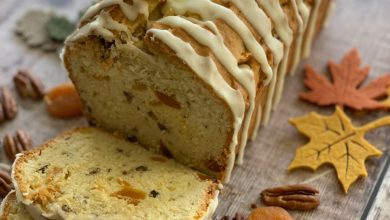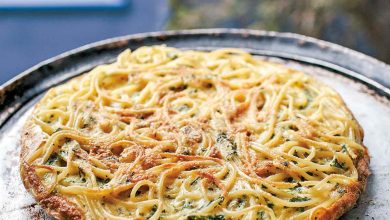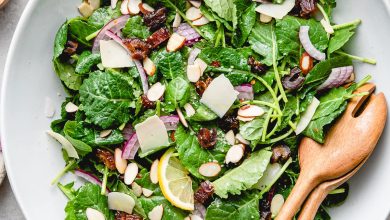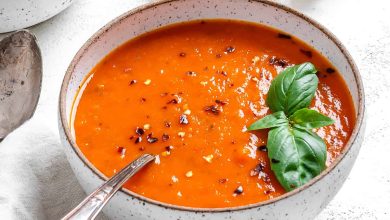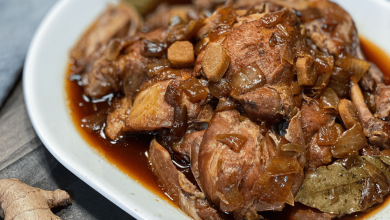Apricot Bread Pudding
🍞🍑 Apricot Bread Pudding: A Sweet Delight 🍑🍞
History 📜:
Apricot bread pudding is a delightful dessert that combines the rich history of bread pudding with the fruity goodness of apricots. Bread pudding itself has ancient origins, with recipes dating back to the 11th century in Europe. It was a thrifty way to use stale bread, making it a popular dessert for centuries. Apricots, on the other hand, have been cultivated for thousands of years, originally hailing from China.
Components 🥖🧁:
To prepare apricot bread pudding, you’ll need:
- 4 cups of stale bread, cubed (usually white or French bread)
- 1 cup of dried apricots, chopped
- 4 large eggs
- 2 cups of whole milk
- 1/2 cup of granulated sugar
- 1 teaspoon of vanilla extract
- 1/2 teaspoon of ground cinnamon
- A pinch of salt
Steps to Prepare 🍳👨🍳:
- Preheat your oven to 350°F (175°C) and grease a baking dish (9×13 inches works well).
- In a large bowl, combine the cubed bread and chopped dried apricots. Mix them together and spread them evenly in the greased baking dish.
- In another bowl, whisk together the eggs, milk, granulated sugar, vanilla extract, ground cinnamon, and a pinch of salt until well combined.
- Pour the egg mixture over the bread and apricot mixture in the baking dish. Make sure all the bread is soaked in the liquid.
- Let the mixture sit for about 15-20 minutes, allowing the bread to absorb the custard.
- Place the baking dish in the preheated oven and bake for approximately 45-50 minutes or until the top is golden brown and the pudding is set. You can check for doneness by inserting a knife into the center; it should come out clean.
- Once done, remove the pudding from the oven and let it cool slightly before serving.
Preparation Time ⏲️:
The total time needed to prepare apricot bread pudding typically ranges from 1 hour to 1 hour and 15 minutes. This includes preparation, baking, and cooling time. It’s a delightful dessert that’s worth the effort, and it can be served warm or at room temperature. You can also add a dusting of powdered sugar or a scoop of vanilla ice cream for an extra touch of sweetness. Enjoy your apricot bread pudding! 🤤👌🍨
Certainly, here are the nutrition facts and some health information for Apricot Bread Pudding:
Nutrition Facts (Approximate values per serving):
- Calories: 320-350 kcal
- Total Fat: 7-9 grams
- Saturated Fat: 3-4 grams
- Cholesterol: 110-130 mg
- Sodium: 220-250 mg
- Total Carbohydrates: 54-60 grams
- Dietary Fiber: 2-3 grams
- Sugars: 32-38 grams
- Protein: 9-10 grams
Health Information:
-
Moderate Calories: Apricot bread pudding can be moderately high in calories, so it’s best enjoyed in moderation as an occasional treat.
-
Protein Source: The eggs and milk in the pudding provide a decent amount of protein, which is essential for various bodily functions, including muscle maintenance and repair.
-
Carbohydrates: The main source of carbohydrates in this dessert comes from the bread and sugar. While it provides quick energy, be mindful of your overall carbohydrate intake, especially if you’re watching your blood sugar levels.
-
Dietary Fiber: While not particularly high in fiber, the dried apricots and bread do contribute some fiber to the dish, aiding digestion and promoting a feeling of fullness.
-
Sugar Content: Apricot bread pudding tends to be on the sweeter side due to the sugar content. It’s advisable for those watching their sugar intake to consume this dessert in moderation.
-
Moderate Fat: The fat content comes from the eggs and any added butter or cream. It’s not overly high, but be mindful of portion size if you’re concerned about fat intake.
-
Vitamins and Minerals: Dried apricots provide essential vitamins and minerals, including vitamin A, potassium, and iron. However, the baking process may reduce the vitamin content.
-
Sodium: The sodium content is relatively low, which is good for those monitoring their salt intake.
-
Indulgent Dessert: While it’s delicious and enjoyable as an occasional treat, it’s important to recognize that apricot bread pudding is not a low-calorie or low-sugar option. It’s best suited for special occasions or as an infrequent indulgence.
Remember that the exact nutritional values can vary based on the specific ingredients and portion sizes used in your recipe. It’s always a good idea to adjust recipes to meet your dietary needs or consult with a nutritionist if you have specific health concerns.


